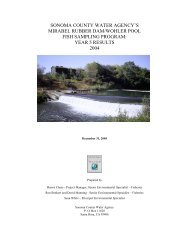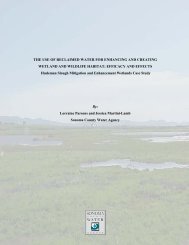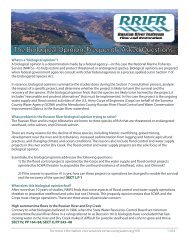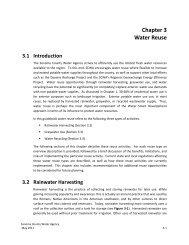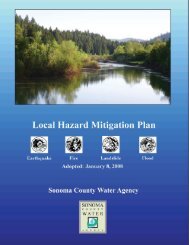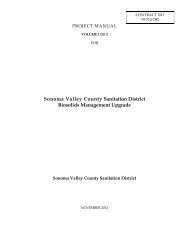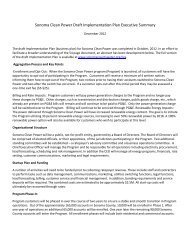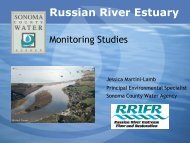Hydrography of the Russian River Estuary - Sonoma County Water ...
Hydrography of the Russian River Estuary - Sonoma County Water ...
Hydrography of the Russian River Estuary - Sonoma County Water ...
You also want an ePaper? Increase the reach of your titles
YUMPU automatically turns print PDFs into web optimized ePapers that Google loves.
All water properties are subject to <strong>the</strong> same patterns <strong>of</strong> transport and mixing, circulating<br />
cooler saline seawater and warmer freshwater through <strong>the</strong> estuary. However, <strong>the</strong> mass<br />
balances that control <strong>the</strong> evolution <strong>of</strong> properties also include non-conservative terms<br />
(such as <strong>the</strong> surface warming <strong>of</strong> water) that differ between properties. Thus salinity<br />
patterns do not match temperature, nutrient or dissolved oxygen patterns and one may<br />
find habitats with any combination <strong>of</strong> property values. As <strong>the</strong>re is nei<strong>the</strong>r source nor sink<br />
for salt dissolved in estuarine waters, salinity is a conservative property and provides<br />
<strong>the</strong> clearest view <strong>of</strong> transport and mixing patterns in <strong>the</strong> estuary. However, <strong>the</strong><br />
distribution <strong>of</strong> temperature, nutrient, or dissolved oxygen in <strong>the</strong> estuary is not simply<br />
explained by <strong>the</strong> mixing <strong>of</strong> freshwater with seawater (as is true for salinity), thus an<br />
explanation <strong>of</strong> distributions also requires knowledge <strong>of</strong> <strong>the</strong> spatial pattern in processes<br />
such surface heating, respiration, and photosyn<strong>the</strong>sis.<br />
3.3.1 – Spatial distribution <strong>of</strong> salinity<br />
The distribution <strong>of</strong> salt in <strong>the</strong> <strong>Russian</strong> <strong>River</strong> estuary is comprised <strong>of</strong> vertical and<br />
longitudinal structures. The longitudinal structure is due to seawater mixing in from <strong>the</strong><br />
mouth while freshwater flows in at <strong>the</strong> landward boundary. The vertical structure is due<br />
to <strong>the</strong> large density difference between seawater and freshwater, so that saltier waters<br />
flow landward beneath seaward flowing low-salinity waters (see plots in Behrens &<br />
Largier 2010).<br />
For convenience, one may identify 3 hydrographic zones in <strong>the</strong> <strong>Russian</strong> <strong>River</strong> estuary:<br />
(i) <strong>the</strong> outer estuary, up to Sheephouse Creek, is characterized by strong tidal currents<br />
and associated fluctuations in salinity; (ii) <strong>the</strong> mid-estuary, from Sheephouse Creek to<br />
Heron Rookery, is characterized by weaker and more variable tidal fluctuations in<br />
salinity and <strong>the</strong> trapping <strong>of</strong> saline water in deeper pools for extended periods <strong>of</strong> time;<br />
and (iii) <strong>the</strong> inner estuary, landward <strong>of</strong> Heron Rookery, is <strong>of</strong>ten completely fresh, but<br />
saline waters intrude under specific tidal conditions or during closure events and<br />
pockets <strong>of</strong> salinity may be retained in deep pools following such an event.<br />
Vertical structure in salinity is strong in <strong>the</strong> <strong>Russian</strong> <strong>River</strong> estuary. While <strong>the</strong> water<br />
column may mix during strong tidal flows, <strong>the</strong> continual inflow <strong>of</strong> river water ensures that<br />
stratification is rapidly re-established as currents weaken hours later or as ebb-tide<br />
straining helps to counter vertical mixing. During neap tides, or as <strong>the</strong> mouth constricts<br />
tidal flows, vertical stratification will persist unbroken, even at stations near <strong>the</strong> mouth.<br />
The wind may also deform or mix <strong>the</strong> surface freshwater layer as surface stress is<br />
imposed directly on this thin low-salinity layer – but, as for <strong>the</strong> tide, as soon as <strong>the</strong> wind<br />
weakens, near-surface stratification is re-established.<br />
35






